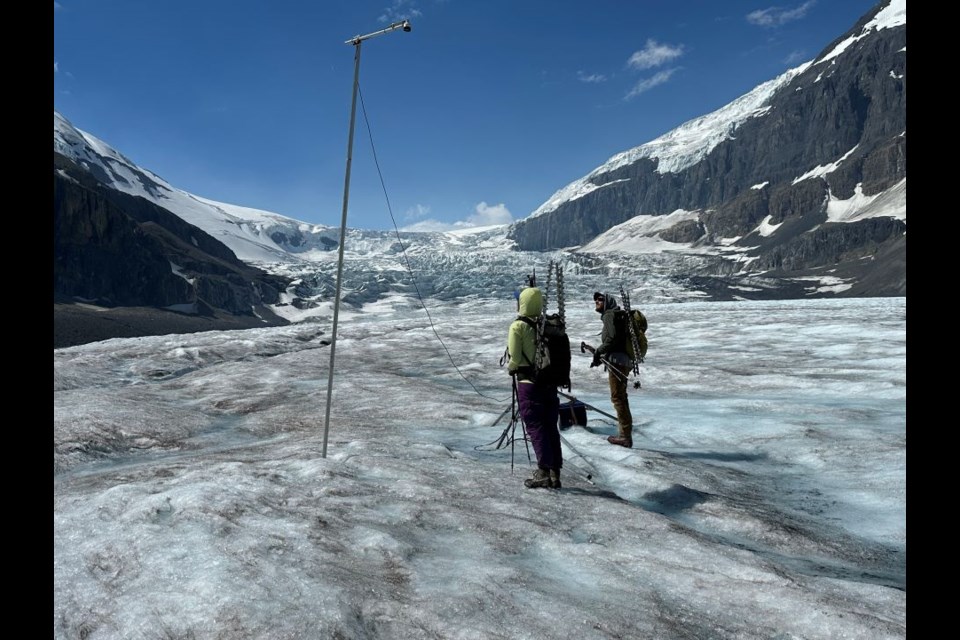John Pomeroy first visited the Athabasca Glacier in Jasper National Park around 45 years ago when it was only a 40-metre walk away from the parking lot.
The hydrologist with the University of Saskatchewan, who has been doing research at the glacier, now describes it as a long walk to get to the ice.
“It has vastly changed over that period of time and continues to retreat,” Pomeroy said. “The Sunwapta Lake formed after the 1950s because ice [has been] retreating for a long time. That was the only lake downstream of the glacier, and now there are three proglacial lakes that have formed in the last decade.”
The Athabasca Glacier had over 40 centimetres of icemelt alone during one week earlier in September and about five metres so far in the last year. In Banff National Park, the Peyto Glacier experienced 4.7 metres of melt this year up to the end of August, which is slightly lower compared to the 6.5 metres in 2023 at that point.
While warmer temperatures are a main culprit, wildfire smoke is darkening the surface of glaciers, which decreases its reflectiveness of sunlight, also known as albedo.
Glaciers should reflect roughly 30 per cent of solar radiation, but in recent years, the Athabasca Glacier has been reflecting only 15 per cent.
“Whether the fires that affected the town of Jasper have affected the glacier, I don't know,” Pomeroy said. “The prevailing winds are usually blowing that smoke to the east, so it’s usually the upland fires in B.C. that affect it more than the local fires in Jasper National Park.”
According to a 2022 study, the darkening of the ice can increase the melt rate of the glacier by up to 10 per cent after the smoke clears.
Researchers determined the rate through careful measurements during wildfires over the course of six years at the Athabasca Glacier. They also used satellites to measure the reflectiveness of ice for the glacier and the entire Columbia Icefield.
“The ice melt doesn't increase while the smoke is still in the sky, but once the smoke has cleared and the ash has been deposited on the glacier, the glacier stays dark for months afterwards,” Pomeroy said. “And algae grow on the ice that holds all the soot particles in place on the ice crystals, and they can hold it there for years, so you get water melt from a wildfire actually a year after the fire.”
He added the bus tours offered on the Athabasca Glacier were largely inconsequential when it comes to melting, noting the tire cleaning for these buses was effective and any diesel exhaust residue was not in enough concentration to darken the ice.
Pomeroy estimated the Athabasca Glacier will be gone by the end of the century, and Peyto Glacier could disappear in a decade.
According to Pomeroy, glaciers help with “drought-proofing” for mountain rivers during the hottest, driest weather. This benefits downstream communities, gives cold water for trout and salmon to thrive and ensures more consistent hydroelectricity generation.
However, he estimated the streamflow in the town of Jasper from the Athabasca River would decrease 14 per cent overall by 2085, and August flows will drop to a quarter of what they are now.
“That’s how much is coming from glacier melt,” he said. “If we look at even by 2040 – so, really, not that far, 15 years in the future – we're looking at flows dropping by 40 per cent in August.”
He added large glaciers, such as those in the Columbia Icefield, modify the climate around them, and as they shrink, the region and other parts of Canada will experience greater warming, which could lead to more wildfires.
Pomeroy noted the only way to preserve glaciers was to preserve the climate, which meant reducing greenhouse gas emissions.
“We're putting the planet into a condition that hasn't existed since humanity has evolved as a species, and it's destroying our natural landscapes and our natural water supplies and our natural life support systems and making our communities uninhabitable in many places, so there’s a great sense of urgency there,” he said.
“We have to get this under control very quickly. We still might not be able to save the Athabasca Glacier, but we can save the Columbia Icefield, and we can maybe still keep our rivers flowing adequately and everything else that we need to sustain life.”




.jpg;w=120;h=80;mode=crop)